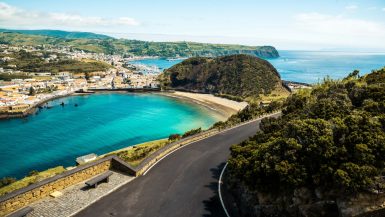
Are the Azores worth visiting? We’re surprised you even had to ask! Seriously – these are some of the most eye-wateringly wonderful islands in the world, let alone just Europe. They’ve got oodles up their sleeve for would-be adventurers and explorers, but also plenty for culture buffs and beach bums.
From the soaring summit of Mount Pico to the black-sand bays of Sao Miguel, the collapsed volcano calderas to the hiking trails through the ancient laurel woods, you’re sure to find something here that will stoke the wanderlust. And that’s not even mentioning the forever-balmy weather, which keeps the thermometers ticking over at between 63-75 F for most of the year.
This guide will run through just seven reasons why we think that these far-flung Portuguese isles should be on your travel radar this year. It will look at the trails you can hike and the towns you can get lost in, along with plenty more besides. So, are the Azores worth visiting?
Because they’re easier to reach than ever before
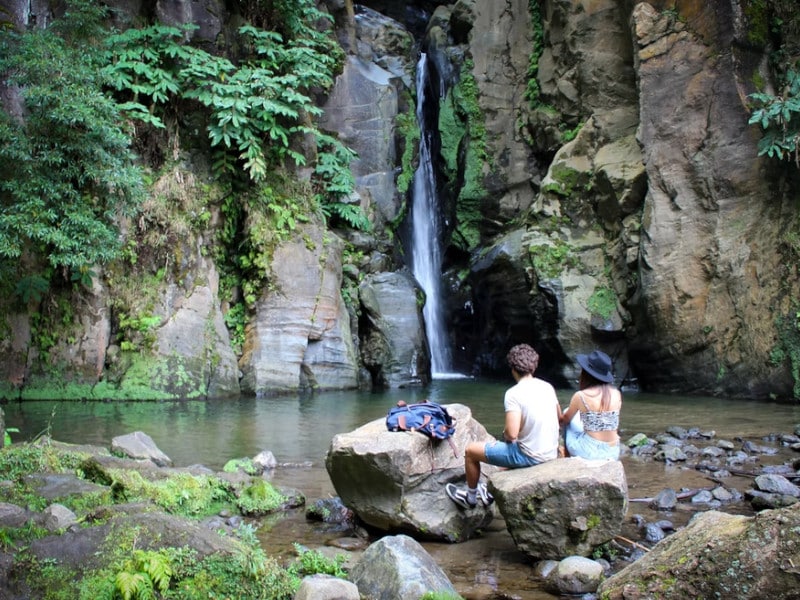
Seriously, the Azores are now more accessible than they’ve ever been. Nope, no one has tug-boated the whole island group closer to Europe or North America. These rocks still sit a whopping 870 miles from Lisbon and 2,500 miles from New York. Their nearest neighbor in the Atlantic is still Madeira some 600 miles to the southwest. But there’s a growing cohort of both budget and premium flights links over that now make jetting in something of a cinch.
A lot of that is down to the arrival of low-costers on the scene. Europe’s biggest wallet-friendly airline Ryanair now even runs direct routes in from Frankfurt, Stansted, Lisbon, and Porto. That’s helped to chop down the price and make the islands more reachable to travelers on a more modest budget.
Then you have the flag-carrier of Portugal, TAP. They’ve got daily links to Ponta Delgada Airport from Funchal in Madeira and the mainland. On top of that, there are regular flights in from the East Coast of the USA on SATA, who jet to PDL airport from Toronto and New England.
For the hiking

If we had to pick one reason and one reason alone why the Azores are certainly worth visiting, it would surely be the hiking. This speckling of Portuguese islets is a veritable mecca for walkers looking to get on the trail somewhere a little different. They come with all sorts of routes – challenging and easy-going, summit pushes and loops – but also cover a whole medley of climactic zones and different habitats.
There’s hiking to be done on every single island. However, there are one or two that really stand out from the crowd when it comes to hoofing it on the trails. The first is Corvo. It’s the home of a collapsed volcanic crater which now has a duo of shimmering lakes and some amazing laurel forests. The second is Pico, where you find the soaring, needle-like summit of the highest peak in Portugal, Mount Pico itself.
Here’s a closer look at some of the bucket-list hikes in the Azores archipelago:
- Mount Pico – This is probably the greatest hiking undertaking in the Azores, whisking you 2,300 meters above the ocean to the roof of the Atlantic.
- Caldeirao Trail – Walk a loop around an ancient crater and see some sweeping 360s of the island of Corvo.
- Lagoa das Sete Cidades – See this gleaming, azure-emerald lake combo on the heights of Sao Miguel.
The island hopping
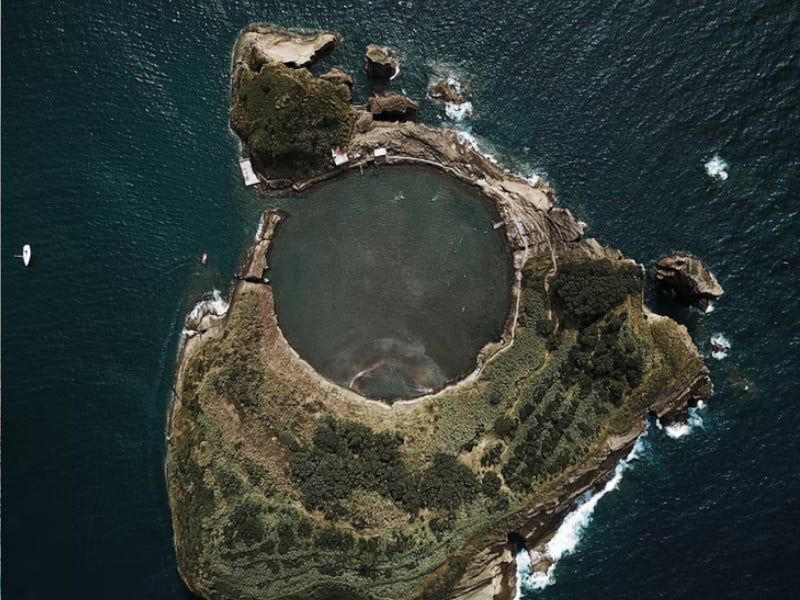
Move over Greece. Take a hike Croatia. The Azores offer island hopping of a whole different caliber. Set across nine different rocks in the middle of the ocean, a seafaring odyssey that takes you from one place to another here can reveal all the various facets of the Portuguese chain, not to mention some fantastic and unforgettable views of the Atlantic’s vast blue along the way.
The good news is that there are pretty efficient public ferry links run by Atlantico-line that can take you from A to B without too much hassle. A couple – the ones linking the main groups of the Azores – only run in the summer season. Most operate all year round, though. There are also plenty of inter-island flights, which we’d say are a top option for hopping between the most distant members of the Azores in no time at all.
If you’re a little short on time, then it can make sense to limit your island hopping in the Azores to just one group. There are the western isles of Corvo and Flores, which are tropical bouts of jungle and rugged rock. You’ve got the eastern isles, Sao Miguel and Sao Pedro, which are uber accessible. And then there’s the largest middle group, which hosts the monstrous volcano of Pico and lovely Faial to boot.
The food

Any trip to Portugal is made better because of the food. It’s a showcasing of the freshness and passion of the Iberian kitchen, making use of the bounty of the Atlantic and the richness of the farming traditions of the nation. You get all that on the Azores plus a hint of tropical pizzazz and a twist of the exotic.
Yep, the mainstay dishes here include the likes of fried mackerel, usually sizzled on BBQ coals and doused in olive oil, and black sausage, often infused with a hint of chili and cinnamon. You’ll also want to dig into platters of griddled pimenta da terra (a sweet but zingy type of pepper that’s grown here in abundance) and the famous Azorean pineapple (notice how they are a touch sweeter and smaller than their mainland compadres).
Then you get the wine. There’s not the same viticulture tradition on the archipelago as in other Portuguese hubs like the Douro Valley and Centro. However, things are starting to move, with all-new labels of award-winning reds emerging from fertile Pico Island and beyond.
The beaches
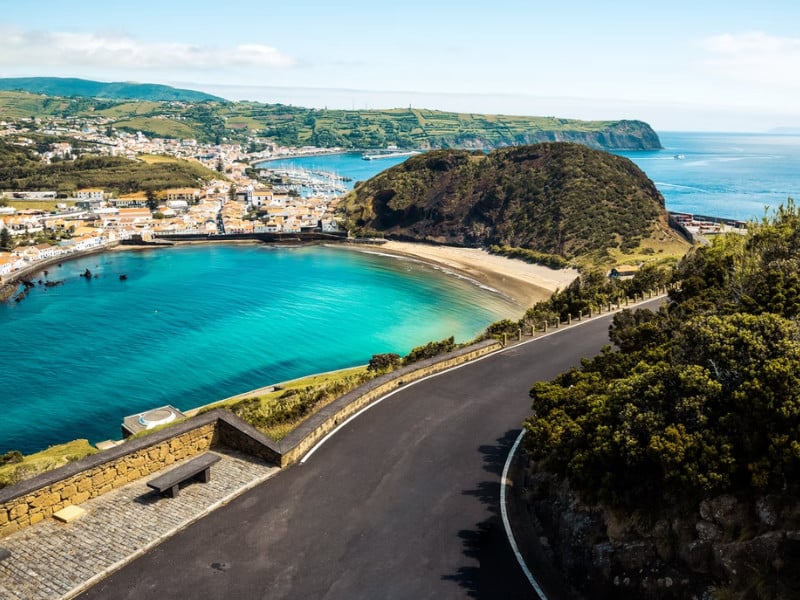
Are the Azores worth visiting for the beaches on their own? Probably not. If all you’re after is golden sands and turquoise seas, then we’d recommend sticking to the Algarve on the Portuguese mainland, where you get idyllic bays with rock stacks and whitewashed resort towns to their back. But that’s not to say that the Azores don’t have some downright awesome coastal spots. They do!
Mhmm…beach lovers should mosey on down to Santa Barbara Beach on Sao Miguel. It’s a blustery stretch of black sand that has waves for surfers and rugged headlands to gawp at. That same island also hosts the quieter beach at Agua de Alto, a rare light-sand option in the group.
However, arguably the best beaches in Azores are on offer over on Santa Maria Island. There, they ditch the darker hues of the volcanic beaches and turn a shimmering shade of sugar white. Check out Praia Formosa for its wave-bashed lagoons, or head to St. Lawrence Beach, where slivers of golden sand hide under the mountains.
The towns and cities
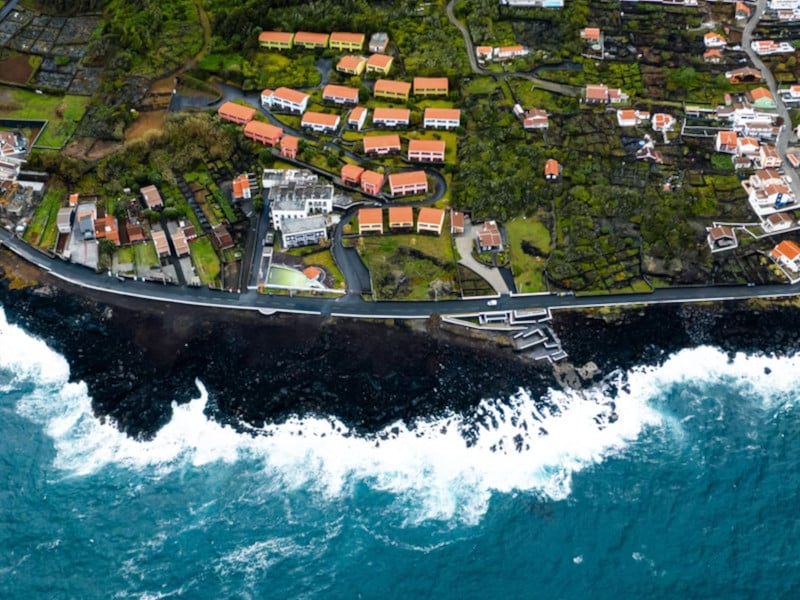
It’s not all lush laurel forests, wave-smashed shorelines, and cloud-piercing volcanos in the Azores, you know? There are towns and cities here; buzzing, lively, lovely, culture-filled towns and cities that are sure to entertain any urban mouse that happens to hop over.
Let’s begin in Ponta Delgada. This is the biggest urban center on the whole archipelago. It’s home to just shy of 70,000 people and serves as the economic and political hub of the region. It’s also got a rich history that stretches back more than 500 years and even witnessed big naval battles that were central to the development of Portuguese history. Today, it’s the only place with real nightlife, which clusters around the old town and the marina, and it boasts some fascinating museums to boot.
There are a number of smaller towns and villages to get through on other islands. Horta is the hub of Faial, for example. It’s a charming clutch of marina bars and old forts set on a lovely headland. Then there’s picturesque Angra do Heroismo up on Terceira, where you’ll find miradouro lookout points and historic European churches.
The remoteness of it all

A lot of travelers are put off by just how distant the Azores can seem from the rest of Europe. But we’d say that’s part of the charm and certainly not a reason to skip coming! The 800 miles or so you need to travel from the edge of Iberia helps to keep the chain feeling remote and off the beaten track.
You don’t get the same booming crowds of sunbathers and sandcastle builders on the shoreline that you get in the Algarve or the Lisbon Estoril Coast. There’s hardly any overdeveloped resort stretches that go on for mile upon mile ruining the natural look of the shore. Even towns like Ponta Delgada are small and quiet compared to their mainland counterparts
More than that, there’s always an opportunity to escape into the lonely backcountry on the Azores. It’s usually just a case of hopping on a bus and, before you know it, you’ll be lost in verdant forests searching for waterfalls or scaling the sides of a steep volcano without another soul in sight.
The joys of the ocean

Being an island group right out in the midst of the Atlantic Ocean means that the Azores are surrounded by saltwater. It’s the common denominator of life in the archipelago; seafaring informs the history, the food, the culture, even the taste in the air. You’re never too far from a wonderful beach, which we’ve waxed lyrical about above. But there’s more, too…
Surfers are coming here in increasing numbers to chase the almost totally-deserted breaks of Areais de Santa Bárbara and Mosteiros on São Miguel. Yachters love the islands because they’re a challenge for even trained skippers and offer a tailor-made point-to-point itinerary. On top of that, there’s ocean kayaking when the swells calm down, coast walking, tide pooling – the list goes on and on and on.
Island art and culture

Don’t go thinking that a trip to the Azores is all about seeing the wilder side of Atlantic Portugal. That’s arguably the main thing, but there’s culture and art on offer in abundance here too. Head down to the UNESCO-tagged center of Angra do Heroísmo on Terceira, a place that brims with eye-catching architecture that dates back to the 1400s! There are also 500-year-old buildings in Ponta Delgada to witness, fronted with glorious designs of tiles and rich paints that help that stand out from the crowd.
The edgier side of the local art scene is there for all to see at the Arquipélago, a center for the arts in Ribeira Grande. Behind the stark and Brutalist exterior there, you’ll find some of the most avant-garde and cutting-edge installation exhibits in the whole country. There’s also the quirky collections of the Museu Carlos Machado, which consist of old-school taxidermy pieces, and the Flores Museum in Santa Cruz, which preserves religious art from the Middle Ages.
Are the Azores worth visiting? Our conclusion
Are the Azores worth visiting? They sure are! These islands cross multiple climate zones and offer stacks of adventure from their place in the very middle of the wild Atlantic Ocean. You can come to hike trails that will take the breath away (literally) with summits sat on the top of volcanos. You can come for blustery beaches of black sand. Or, come for enthralling towns that were settled by explorers more than half a millennium ago.
How long do I need in the Azores?
We usually recommend at least a week in the Azores. These islands are quite far from the European mainland and the US, so it’s worth spending a little extra here because it takes longer to fly over. On top of that, there are plenty of islands to see – nine main islands in all. You could spend months exploring and not see it all, but at least seven days is a good start.
When’s the best time to visit the Azores?
Most people will visit the Azores in the summer, between June and August. That’s the drier and the hotter time of the year, and when most of the seasonal flight connections run from Portugal. The rainy season starts in October most years. It can be lovely, but it can also sometimes be very wet. That said, it’s the better option if you want to keep costs down and escape the crowds.


